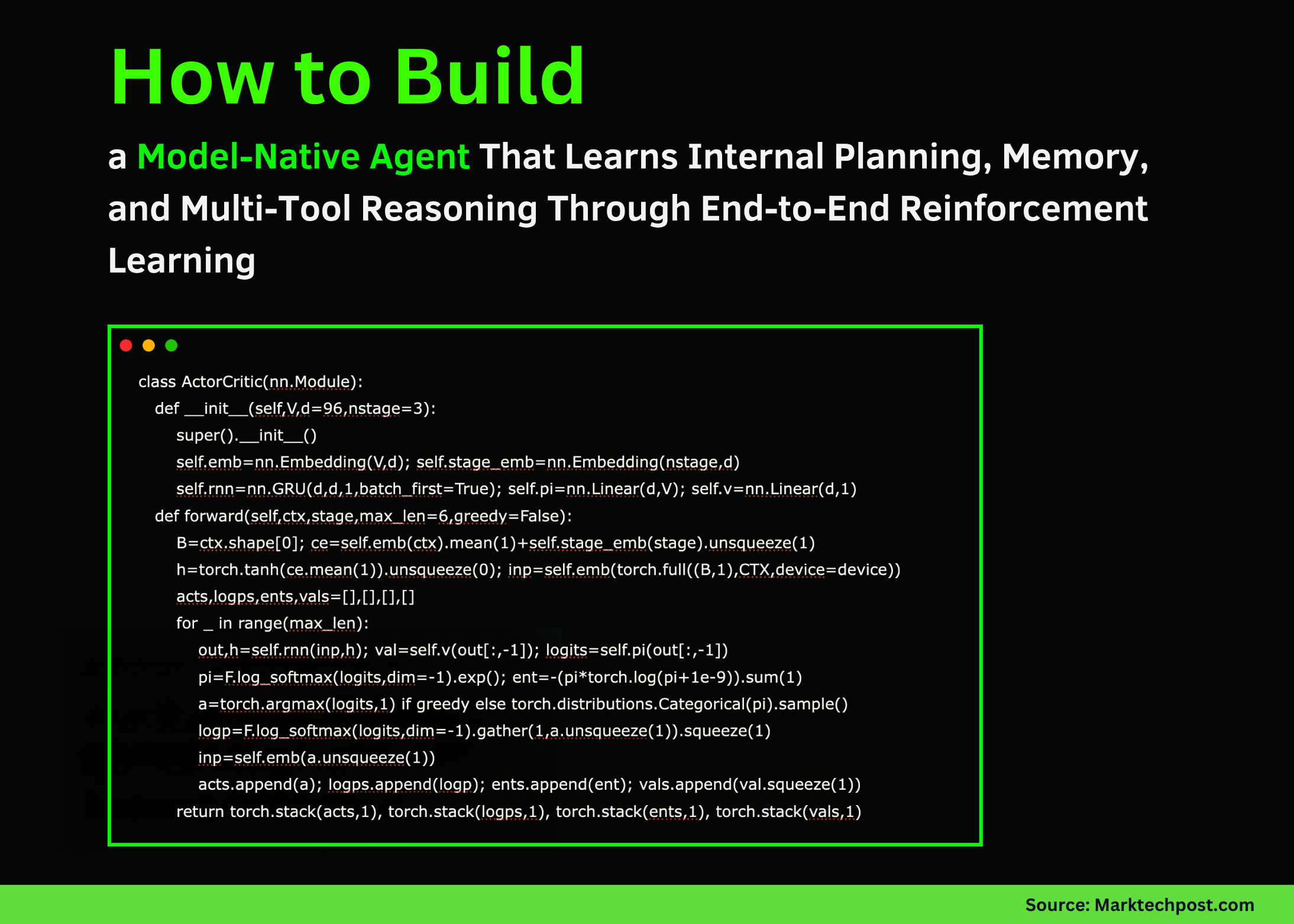In this tutorial, we explore how an agent can internalize planning, memory, and tool use within a single neural model rather than relying on external orchestration. We design a compact, model-native agent that learns to perform arithmetic reasoning tasks through reinforcement learning. By combining a stage-aware actor-critic network with a curriculum of increasingly complex environments, we enable the agent to discover how to use internalized “tools” and short-term memory to reach correct solutions end-to-end. We work step by step to observe how learning evolves from simple reasoning to multi-step compositional behavior. Check out the FULL CODES here.
import math, random, torch, torch.nn as nn, torch.nn.functional as F
device = "cuda" if torch.cuda.is_available() else "cpu"; torch.manual_seed(0); random.seed(0)
V = 18; CTX = 10; MUL, ADD, SUB, ANS, STO, RCL, EOS = 11, 12, 13, 14, 15, 16, 17
tok2str = {**{i: str(i) for i in range(10)}, CTX:"[CTX]", MUL:"[MUL]", ADD:"[ADD]", SUB:"[SUB]", ANS:"[ANS]", STO:"[STO]", RCL:"[RCL]", EOS:"[EOS]"}
class ToolEnv:
def __init__(self, max_steps=7):
self.max_steps = max_steps
def sample(self, stage):
a,b,c,d,e = [random.randint(0,9) for _ in range(5)]
if stage==0: ctx=[a,b,c]; target=a*b+c
elif stage==1: ctx=[a,b,c,d]; target=(a*b+c)-d
else: ctx=[a,b,c,d,e]; target=(a*b+c)-(d*e)
return ctx, target, (a,b,c,d,e)
def step_seq(self, actions, abc, stage):
a,b,c,d,e = abc; last=None; mem=None; steps=0; shaped=0.0
goal0=a*b; goal1=goal0+c; goal2=goal1-d; goal3=d*e; goal4=goal1-goal3
for act in actions:
steps+=1
if act==MUL: last=(a*b if last is None else last*(d if stage>0 else 1))
elif act==ADD and last is not None: last+=c
elif act==SUB and last is not None:
last -= (e if stage==2 and mem=="use_d" else (d if stage>0 else 0))
elif act==STO: mem="use_d" if stage>=1 else "ok"
elif act==RCL and mem is not None:
last = (d*e) if (stage==2 and mem=="use_d") else (last if last else 0)
elif act==ANS:
target=[goal0,goal1,goal2,goal4][stage] if stage==2 else [goal0,goal1,goal2][stage]
correct=(last==target)
if stage==0: shaped += 0.25*(last==goal0)+0.5*(last==goal1)
if stage==1: shaped += 0.25*(last==goal0)+0.5*(last==goal1)+0.75*(last==goal2)
if stage==2: shaped += 0.2*(last==goal0)+0.4*(last==goal1)+0.6*(last==goal4)+0.6*(last==goal3)
return (1.0 if correct else 0.0)+0.2*shaped, steps
if steps>=self.max_steps: break
return 0.0, stepsWe begin by setting up the environment and defining the symbolic tools our agent can use. We create a small synthetic world where each action, such as multiplication, addition, or subtraction, acts as an internal tool. This environment enables us to simulate reasoning tasks in which the agent must plan sequences of tool use to arrive at the correct answer. Check out the FULL CODES here.
class ActorCritic(nn.Module):
def __init__(self,V,d=96,nstage=3):
super().__init__()
self.emb=nn.Embedding(V,d); self.stage_emb=nn.Embedding(nstage,d)
self.rnn=nn.GRU(d,d,1,batch_first=True); self.pi=nn.Linear(d,V); self.v=nn.Linear(d,1)
def forward(self,ctx,stage,max_len=6,greedy=False):
B=ctx.shape[0]; ce=self.emb(ctx).mean(1)+self.stage_emb(stage).unsqueeze(1)
h=torch.tanh(ce.mean(1)).unsqueeze(0); inp=self.emb(torch.full((B,1),CTX,device=device))
acts,logps,ents,vals=[],[],[],[]
for _ in range(max_len):
out,h=self.rnn(inp,h); val=self.v(out[:,-1]); logits=self.pi(out[:,-1])
pi=F.log_softmax(logits,dim=-1).exp(); ent=-(pi*torch.log(pi+1e-9)).sum(1)
a=torch.argmax(logits,1) if greedy else torch.distributions.Categorical(pi).sample()
logp=F.log_softmax(logits,dim=-1).gather(1,a.unsqueeze(1)).squeeze(1)
inp=self.emb(a.unsqueeze(1))
acts.append(a); logps.append(logp); ents.append(ent); vals.append(val.squeeze(1))
return torch.stack(acts,1), torch.stack(logps,1), torch.stack(ents,1), torch.stack(vals,1)We then design our model-native policy using an actor-critic structure built around a GRU. We embed both tokens and task stages, allowing the network to adapt its reasoning depth according to task complexity. This setup enables the agent to learn contextually when and how to use internal tools within a single unified model. Check out the FULL CODES here.
env=ToolEnv(); net=ActorCritic(V).to(device)
opt=torch.optim.Adam(net.parameters(),lr=3e-4)
def pad_batch(ctxs):
L=max(len(c)+1 for c in ctxs)
out=torch.full((len(ctxs),L),EOS,dtype=torch.long,device=device)
for i,c in enumerate(ctxs): out[i,:len(c)+1]=torch.tensor(c+[CTX],device=device)
return out
def run_batch(stage,batch=128,train=True,greedy=False):
ctxs=[]; metas=[]
for _ in range(batch):
c,t,abc=env.sample(stage); ctxs.append(c); metas.append((t,abc))
ctx=pad_batch(ctxs); stage_t=torch.full((batch,),stage,device=device,dtype=torch.long)
acts,logps,ents,vals=net(ctx,stage_t,max_len=6,greedy=greedy)
rewards=[]
for i in range(batch):
traj = acts[i].tolist()
abc = metas[i][1]
r,_ = env.step_seq(traj,abc,stage)
rewards.append(r)
R=torch.tensor(rewards,device=device).float()
adv=(R-vals.sum(1)).detach()
if not train: return R.mean().item(), 0.0
pg=-(logps.sum(1)*adv).mean(); vloss=F.mse_loss(vals.sum(1),R); ent=-ents.mean()
loss=pg+0.5*vloss+0.01*ent
opt.zero_grad(); loss.backward(); nn.utils.clip_grad_norm_(net.parameters(),1.0); opt.step()
return R.mean().item(), loss.item()We implement the reinforcement learning training loop using an advantage actor-critic (A2C) update. We train the agent end-to-end across batches of synthetic problems, updating policy and value networks simultaneously. Here, we incorporate entropy regularization to promote exploration and prevent premature convergence. Check out the FULL CODES here.
print("Training…")
stages=[0,0,0,1,1,2]
for ep in range(1,61):
stage=stages[min((ep-1)//10,len(stages)-1)]
acc,loss=run_batch(stage,batch=192,train=True)
if ep%5==0:
with torch.no_grad():
evals=[run_batch(s,train=False,greedy=True)[0] for s in [0,1,2]]
print(f"ep={ep:02d} stage={stage} acc={acc:.3f} | eval T0={evals[0]:.3f} "
f"T1={evals[1]:.3f} T2={evals[2]:.3f} loss={loss:.3f}")We start the main training process using a curriculum strategy where tasks gradually increase in difficulty. As we train, we evaluate the agent on all stages to observe its ability to generalize from simpler to more complex reasoning steps. The printed metrics show how internal planning improves over time. Check out the FULL CODES here.
def explain(stage):
c,t,abc=env.sample(stage)
ctx=pad_batch([c]); stage_t=torch.tensor([stage],device=device)
with torch.no_grad(): a,_,_,_=net(ctx,stage_t,greedy=True)
seq=[tok2str[x] for x in a[0].tolist()]
r,_=env.step_seq(a[0].tolist(),abc,stage)
return dict(stage=stage,ctx=c,target=t,actions=" ".join(seq),reward=round(float(r),2))
with torch.no_grad():
for s in [0,1,2]:
print(f"nStage {s} samples:")
for _ in range(5): print(explain(s))
with torch.no_grad():
finals=[run_batch(s,train=False,greedy=True,batch=1000)[0] for s in [0,1,2]]
print(f"nFinal greedy accuracies → T0={finals[0]:.3f}, T1={finals[1]:.3f}, T2={finals[2]:.3f}")We finish by probing the trained agent and printing example reasoning trajectories. We visualize the sequence of tool tokens the model chooses and verify whether it reaches the correct result. Finally, we evaluate the overall performance, demonstrating that the model successfully integrates planning, memory, and reasoning into an internalized process.
In conclusion, we see that even a neural network can learn internalized planning and tool-use behaviors when trained with reinforcement signals. We successfully move beyond traditional pipeline-style architectures, where memory, planning, and execution are separate, toward a model-native agent that integrates these components as part of its learned dynamics. This approach represents a shift in agentic AI, demonstrating how end-to-end learning can produce emergent reasoning and self-organized decision-making without the need for handcrafted control loops.
Check out the FULL CODES here. Feel free to check out our GitHub Page for Tutorials, Codes and Notebooks. Also, feel free to follow us on Twitter and don’t forget to join our 100k+ ML SubReddit and Subscribe to our Newsletter. Wait! are you on telegram? now you can join us on telegram as well.
The post How to Build a Model-Native Agent That Learns Internal Planning, Memory, and Multi-Tool Reasoning Through End-to-End Reinforcement Learning appeared first on MarkTechPost.



